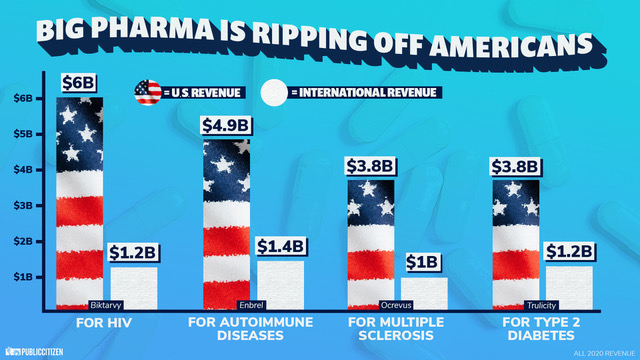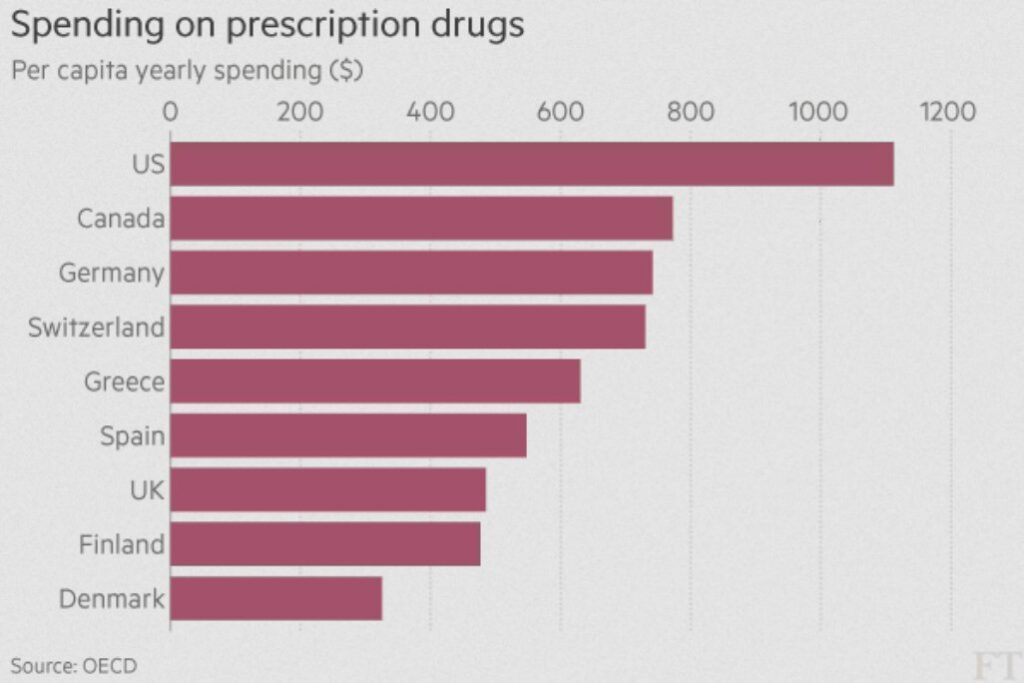
Here’s a riddle that SA’s astute readers are sure to solve. What world-wide industry brought home $1.78 trillion in revenues, with the U.S., as usual the biggest spender on the planet, responsible for 41% of that $1.48 trillion. The second-place finisher, China, had only a 12% share. Think about it, China’s 12% share was spread among 1.5 billion people (18.5% of the world population) while the U.S. 41% share was spread among only 337,000 (4.25% of the world’s population). Feels like one of those “looking glass” moments where the world suddenly appears unfamiliar, almost as if things were turned upside down.
You’ve probably guessed it by now, but here are a few more hints. More than two-thirds of Americans (70%) use at least one of these products, one-quarter use four. Certainly explains why this industry managed to make well over a half trillion dollars in the U.S.
You get an A if you guessed the pharmaceutical industry (big pharma) whose CEOs, all millionaires and billionaires, are in the driver’s seat when it comes to medicating an already over-medicated America. Without government regulation of any sort, getting sick in America is an expensive and deadly proposition. Think it’s disinformation? Johns Hopkins would disagree. In a 2016 study, they calculated that more than 250,000 people in the U.S. die every year from medical errors, making it the third leading cause of all U.S. deaths (heart disease and cancer are numbers 1 and 2). A big part of those “medical errors” —“Mix-ups with the doses or types of medication patients receive.” [from the report]
A sucker may be born every day. But when it comes to big pharma that sucker is primarily born in the U.S. In 2021, the Rand think tank, whose major client is the U.S. government, reported that prescription drug prices are 2½ times higher in the U.S. than in nine other advanced economies including Canada, Germany, the U.K. and Japan. Equally depressing, in the U.S., brand name drugs (as opposed to generics) are almost 5 times more expensive, accounting for 84% of drug costs in the U.S. although only 8% of drugs dispensed.

Let’s look at the prices, especially of cancer drugs, whose unaffordability is literally killing cancer patients. Since cancer is the second leading cause of death in the U.S. taking the lives of over 609,000 annually, it would have to be a pretty heartless industry that lets greed overcome compassion. Step right up friends, that’s big pharma’s business model, that and of course greed. In four years between 2017 and 2021, the average price of a new cancer drug rose by more than twenty-five percent to more than $235,000 (Report coming out of Senator Katie Porter’s [D-CA] Office). That’s not the worst of it. The exorbitant price of cancer drugs generally —two examples Keytruda ($175,000 per year), Ibrance ($144,000 per year) —means many cancer patients must come up with an average of $16,500 out of their own pocket. How do they manage that? A poll of 1,000 cancer patients plumbs the depths of their desperation: “More than 70% of respondents said they made significant lifestyle changes in order to afford care, including delaying major purchases [36%], depleting most or all of their savings [28%], going into more credit card debt [28%], and borrowing money from relatives and friends [20%].” [American Cancer Society Action Network]
Unlike in every other advanced economy where government regulations put a brake on drug company greed, U.S. patients with no government oversight, are on their own in the wild and wooly world of drug company pricing. Think of it, the price of the same drug sold in the U.S. cost 118% more in the U.S. than in Canada, 155% more than in the U.K., 205% more than in South Korea, and an earth shattering 679% more than in Turkey. [2022]
Not only does the government not run interference for people in their quest for an equitable chance at living a long and healthy life, the feds actually function as silent partners financing big pharma’s research and contributing to big pharma’s fleecing of America. “Congress provided nearly $54 billion for biomedical research…and NIH alone has a budget of $47.5 billion making it the largest biomedical research funder in the world” [Report from the Bernie Sanders led HELP committee] Despite the government’s considerable investment in the research, testing, and manufacture of new drugs on behalf of the bottom feeders at big pharma, when it comes to getting the biggest bang for their buck, the administrators who run these agencies often settle for royalties as low as 1%. Not a terrific return on investment for the taxpayers. Here’s Bernie Sanders restating the obvious — “It is unacceptable that half of new…drugs invented with the help of NIH scientists cost more than $111,000 [per year]…What makes the greed of the pharmaceutical industry so reprehensible is…that the American people are paying twice… First through their taxes and a second time at the pharmacy counter.”
As Americans have surely noticed for some time, talking big and doing nothing seems to sum up life as a Washington lawmaker. “For decades powerful pharmaceutical companies…have repeatedly abused the patent system to stifle competition…showing no regard for the harm done to patients through sustained high prices.” [Elizabeth Warren and Pramila Jayapal, leading lights of what passes for progressive lawmakers, talking big and doing nothing]
With friends like these…

How do we rein in the drug companies’ greed so that U.S. patients cease to be virtually the entire profit center of the drug industry? In every other advanced nation, government agencies regulate how drugs are priced and government negotiators bargain with the drug companies to get the fairest prices they can for taxpayers. In the U.S. lawmakers come to big pharma on their knees. In 2021, President Biden signed the Inflation Reduction Act which included baby steps at taming the drug companies. Woefully inadequate despite a lot of fist-bumping and chest-pounding from the democrats, this provision may give the government the right to negotiate the prices of a limited number of drugs already past their prime money-making opportunities. No surprise to any American used to the government’s strong dislike for challenging its overlords, the law will not take effect until five years after it was passed (2026). And the law only applies to Medicare patients further reducing its effectiveness.
Wouldn’t you know it, big pharma is already trying to torpedo this weak sister, although they will continue to bilk the public six ways to Sunday on drugs still under patent. But the drug companies are not going to let this particular camel get its nose under the tent. Merck, which generated $14.5 billion in profits last year, wants the Biden administration to cease and desist from negotiating drug prices. A bunch of sly dogs, they know how powerfully negotiations can change the equation. Look at Europe where negotiations are king. In one instance, Merck agreed to charge European patients for the same drug [Keytruda] that costs U.S. patients $175,000, only $6,500.

What’s stopping the richest, most powerful country in the world from making the same deal for its people? The short answer is money, the longer answer is control. Big pharma has a stranglehold on congress from both angles. In 2022 the pharmaceutical lobby spent $29 million lobbying to ensure that Congress would maintain its “hands off” policy on drug pricing. To cement that understanding, big pharma contributed to the election campaigns of two-thirds of congress. Included in that total for the 2020 elections are two familiar names—Sen. Bernie Sanders, who after attacking Joe Biden for taking pharma money in 2019, took just under $1.1 million from them. Sen. Elizabeth Warren, who also decried the industry during a 2019 presidential debate, took $615,000 in 2020.
When it comes to presidential politics, big pharma knew which horse to back. They showered Biden with $8.8 million in campaign contributions while giving Donald Trump a measly 2.8 million.
Clearly they believed Biden when he promised during the 2020 campaign that “nothing would fundamentally change.” That’s one promise he kept.
What it boils down to is a recipe for inaction: Congress bought and paid for, the executive branch similarly taken care of. While Congress and the president are living large, almost a quarter of US adults cannot fill their prescriptions because they cannot afford them.
What’s wrong with this picture?
699 total views, 1 views today
